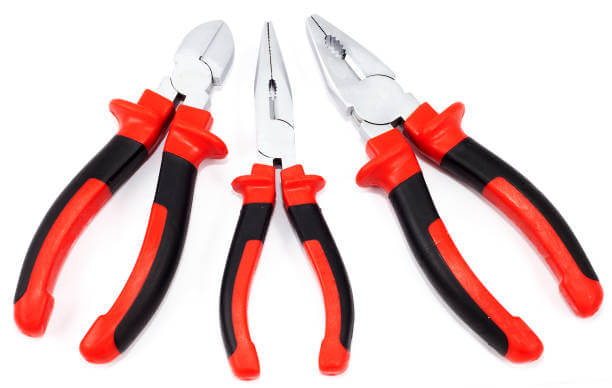Pliers are hand tools used for gripping, bending, and cutting a variety of materials. The word “pliers” is derived from the French word “plier,” which means “to bend.” The name is thought to have originated from the tool’s primary function of bending and shaping metal.
This is likely a reference to the fact that pliers have the ability to fold or grip objects, thanks to their hinged design. The word “pliers” has been in use in English since the mid-15th century, and has remained relatively unchanged over time.

Pliers have been used for centuries and have evolved over time to meet the needs of different tasks and industries.
A very interesting story of the plier
One day, a group of blacksmiths in the Middle East was working hard in their forge, pounding and shaping hot metal into various tools and weapons. One of the blacksmiths, named Hassan, was struggling to bend a particularly stubborn piece of metal. He had tried using his hands and a variety of other tools, but nothing seemed to work.
Frustrated, Hassan walked over to his workbench and rummaged through his tools, searching for something that might help. After a moment, he came across a pair of pliers that he had recently made. They were a simple design, with a single pivot point and a pair of jaws that could be opened and closed by hand.

Hassan grabbed the pliers and returned to his work. He placed the jaws of the pliers around the stubborn piece of metal and squeezed them together. To his surprise, the pliers easily bent the metal to the shape he desired. Hassan was thrilled with his new invention and quickly shared it with his fellow blacksmiths.
The other blacksmiths were equally impressed by the pliers and began using them in their own work. Soon, the pliers became an essential tool in the blacksmith’s workshop and were used to bend, shape, and cut a variety of metals.
History of pliers hand tools, how it’s made?
The earliest known pliers were found in ancient Egyptian tombs and were made of bronze. These early pliers were relatively simple tools with a single pivot point and a pair of jaws that could be opened and closed by hand.
Over time, pliers have evolved and have been adapted for a wide range of tasks and industries. Today, pliers are made using a variety of materials, including steel, stainless steel, and other alloys. The manufacturing process for pliers begins with the selection of raw materials, which are then cut and shaped into the desired form.

Next, the materials are heat-treated to increase their strength and durability. After heat treatment, the pliers are ground and polished to give them a smooth, finished appearance.
Finally, the pliers are inspected and tested to ensure that they meet the necessary quality standards.
There are many different types of pliers available, each designed for specific tasks. For example, needle-nose pliers have long, thin jaws that are well-suited for gripping small objects, while slip-joint pliers have a movable pivot point that allows the jaws to be adjusted for different size objects.
Regardless of the type of pliers, the basic design and function remain the same: a pair of jaws that can be opened and closed to grip or cut materials.
Who invented the plier?
The exact origin of pliers is not known, but they have been in use for centuries. Pliers are believed to have originated in the Middle East and were first used by blacksmiths and metalworkers to bend and shape metal.

When were pliers invented?
The exact date of the invention of pliers is not known, but they have been in use for centuries. Pliers originated in the Middle East to bend and shape metal. It’s believed the first pliers were invented more than 5000 years ago, around 3000 BC.
Pliers were perfect innovations in the world of hand tools. After their invention, thousands of years ago, they have changed a lot; and now, there are few jobs in the world of tools that don’t require a plier.
There are pliers with different models, brands, qualities, etc. in the market and each of them can finish a particular job for you.
What are aliases of pliers?
Some common synonyms or aliases for pliers include:
- Pincers: This term refers to a pair of tongs or forceps that are used for gripping or holding small objects.
- Tongs: This term refers to a pair of long-handled tools with jaws at one end that is used for gripping or holding objects.
- Forceps: This term refers to a pair of long, slender instruments with flat jaws that are used for grasping or holding small objects.
- Tweezers: This term refers to a pair of small, pointed instruments with flat jaws that are used for gripping or holding small objects.
- Nippers: This term refers to a small pair of pliers with short jaws that are used for cutting or trimming small objects.
Despite their many different names and uses, all of these tools share the common feature of a pair of jaws that can be opened and closed to grip or cut materials.

What are other names for pliers?
Some other common names for pliers include:
- Needle-nose pliers: This type of plier has long, thin jaws that are well-suited for gripping small objects.
- Slip-joint pliers: This type of plier has a movable pivot point that allows the jaws to be adjusted for different size objects.
- Lineman pliers: This type of plier is specifically designed for use in electrical work and has long, narrow jaws with sharp, serrated edges.
- Diagonal cutting pliers: This type of plier is used for cutting wire and has jaws with angled cutting edges.
- Channel-lock pliers: This type of plier has wide, adjustable jaws that can be locked in place for added grip and leverage.
- Water pump pliers: This type of plier has long, adjustable jaws that can be locked in place for added grip and leverage.
Today, there are many types of pliers available, each designed for specific tasks such as cutting wire, gripping objects, or bending sheet metal.